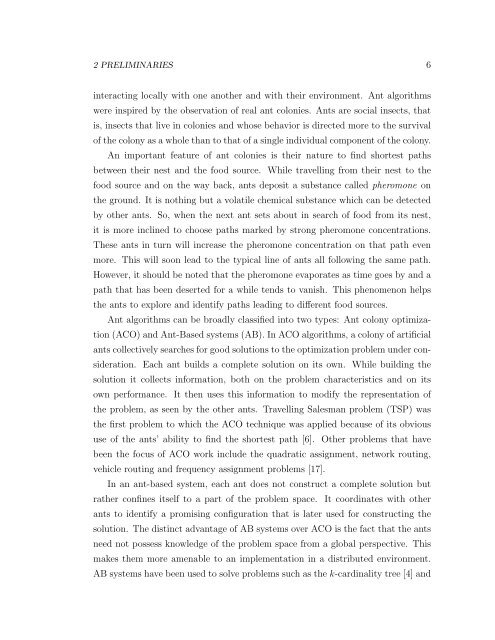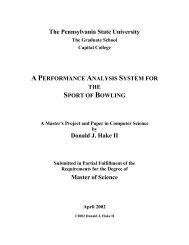An Ant-Based Algorithm for the Minimum Vertex Cover Problem
An Ant-Based Algorithm for the Minimum Vertex Cover Problem
An Ant-Based Algorithm for the Minimum Vertex Cover Problem
You also want an ePaper? Increase the reach of your titles
YUMPU automatically turns print PDFs into web optimized ePapers that Google loves.
2 PRELIMINARIES 6interacting locally with one ano<strong>the</strong>r and with <strong>the</strong>ir environment. <strong>An</strong>t algorithmswere inspired by <strong>the</strong> observation of real ant colonies. <strong>An</strong>ts are social insects, thatis, insects that live in colonies and whose behavior is directed more to <strong>the</strong> survivalof <strong>the</strong> colony as a whole than to that of a single individual component of <strong>the</strong> colony.<strong>An</strong> important feature of ant colonies is <strong>the</strong>ir nature to find shortest pathsbetween <strong>the</strong>ir nest and <strong>the</strong> food source. While travelling from <strong>the</strong>ir nest to <strong>the</strong>food source and on <strong>the</strong> way back, ants deposit a substance called pheromone on<strong>the</strong> ground. It is nothing but a volatile chemical substance which can be detectedby o<strong>the</strong>r ants. So, when <strong>the</strong> next ant sets about in search of food from its nest,it is more inclined to choose paths marked by strong pheromone concentrations.These ants in turn will increase <strong>the</strong> pheromone concentration on that path evenmore. This will soon lead to <strong>the</strong> typical line of ants all following <strong>the</strong> same path.However, it should be noted that <strong>the</strong> pheromone evaporates as time goes by and apath that has been deserted <strong>for</strong> a while tends to vanish. This phenomenon helps<strong>the</strong> ants to explore and identify paths leading to different food sources.<strong>An</strong>t algorithms can be broadly classified into two types: <strong>An</strong>t colony optimization(ACO) and <strong>An</strong>t-<strong>Based</strong> systems (AB). In ACO algorithms, a colony of artificialants collectively searches <strong>for</strong> good solutions to <strong>the</strong> optimization problem under consideration.Each ant builds a complete solution on its own. While building <strong>the</strong>solution it collects in<strong>for</strong>mation, both on <strong>the</strong> problem characteristics and on itsown per<strong>for</strong>mance. It <strong>the</strong>n uses this in<strong>for</strong>mation to modify <strong>the</strong> representation of<strong>the</strong> problem, as seen by <strong>the</strong> o<strong>the</strong>r ants. Travelling Salesman problem (TSP) was<strong>the</strong> first problem to which <strong>the</strong> ACO technique was applied because of its obvioususe of <strong>the</strong> ants’ ability to find <strong>the</strong> shortest path [6]. O<strong>the</strong>r problems that havebeen <strong>the</strong> focus of ACO work include <strong>the</strong> quadratic assignment, network routing,vehicle routing and frequency assignment problems [17].In an ant-based system, each ant does not construct a complete solution butra<strong>the</strong>r confines itself to a part of <strong>the</strong> problem space. It coordinates with o<strong>the</strong>rants to identify a promising configuration that is later used <strong>for</strong> constructing <strong>the</strong>solution. The distinct advantage of AB systems over ACO is <strong>the</strong> fact that <strong>the</strong> antsneed not possess knowledge of <strong>the</strong> problem space from a global perspective. Thismakes <strong>the</strong>m more amenable to an implementation in a distributed environment.AB systems have been used to solve problems such as <strong>the</strong> k-cardinality tree [4] and
















